1/48 Revell / Monogram Spitfire Mk.II
Inspired by Dimitry's beautiful 1/72 Airfix Mk1 early Spitfire, I decided to post up one of mine...
Here's another "oldie" that I built many years ago. It's nothing fancy, but it is a Spitfire, and that's what matters...
These kits look decent right out of the box, and with a little extra work, I'm sure they can look even better.
When I built this one, I didn't have access to the internet. I simply relied on the kit instructions. I didn't know about the "A" pattern camouflage, or that they even had a mirror image pattern and called it the "B" pattern. I didn't know about the hard edge since rubber matts were used for spraying, similar to how Curtiss built P-40's for the RAF. The colors may not be 100 percent correct either, but that's OK. I had a lot of fun building it...
I'm still learning something new about the Spitfire when the opportunity is there. It's a great plane, and probably the most elegant plane to ever grace the skies.
This one used no filler, (if memory serves me), and it shows along the wing to fuselage joint, along with a few other areas... I also ended up with a very nasty looking step under the wing, where it joins the fuselage. Had I the chance to build it over again, I would have fixed these areas.
It was sprayed using a Testors "Aztek" air brush. Model Master enamels were used throughout, as were the kit supplied decals. There is some silvering of the decals, probably because back then I didn't know that a glossy surface was needed to help keep this from happening...
As usual, comments are encouraged.


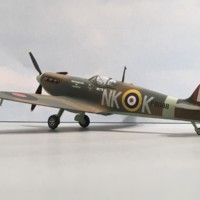
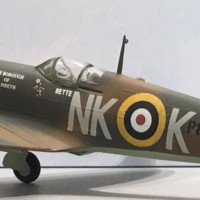


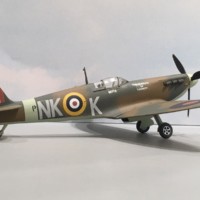
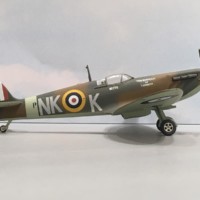

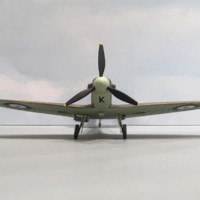

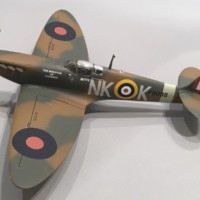

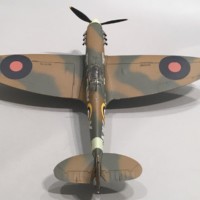

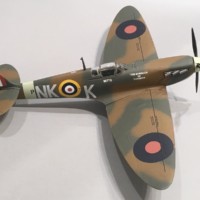
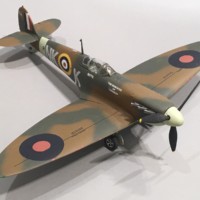
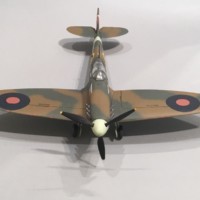
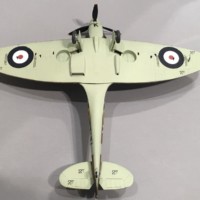

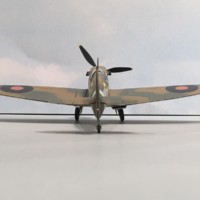
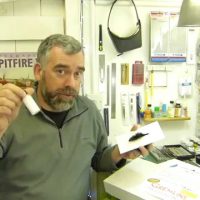
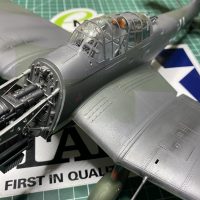


Stood (and stands) the "test of time" well, my friend. After all...it IS - as you said - A Spitfire (AND a Monogram) - so what's not to like? 🙂
Thanks Craig... your comments pretty much nailed it... my feeling exactly. Monogram and a Spit 🙂
Handsome Spit!
Thanks Greg !
You said - "Monogram and a Spit" (Oh, yeah) 😉
That pretty much says it all! These old Mono kits have, as Craig said, stood the test of time. I still have one of the exact kits in my stash waiting for me to build. It's an original kit from when it was a new release, or shortly thereafter.
Beautifully done, Louis!
Thanks Jeff. I appreciate the compliments buddy. Go for it and take a crack at your Spitfire. It's a fun little kit to build. Not too many parts in it either.
You'll have to forward what you know of the camo patterns, Louis, before I put my foot in it with the Mossie in my stash...
I'll send you a message with what I have learned about this. It's really pretty simple stuff.
Ah, that dihedral combined with the elliptical wing. I think she's almost impossibly beautiful. My first love.
It was also my first balsa wood model. I built the 16 1/2" wingspan Guillows kit when I was a kid. You nailed it again David.
Great looking Spitfire, Lou!
Thanks Bob !
Looks fabulous! That’s a nice little kit. Originally released by a Revell in ‘78 I believe. Thanks for sharing this with us.
You're absolutely correct Lee. It's heritage goes back a while to say the least. Thanks !
Actually this whole business about hard edge camouflage by use of rubber mats is an old wive's tale. In truth, they chalked the outline, and then used a spraygun that was tightened down to minimum to paint the outline of the green over either the dark earth or the grey. From a distance further than six feet, the result looks "hard edge", and can only be seen as a tight spray from about one foot (1/4 inch in 1/48). In truth, no two airplanes were exactly alike in pattern, as can be seen in a photo recently found of three Lancaster fuselages right up next to each other in the paint shop. All close, none exact copies. Think about it, hauling around rubber matts and placing them exactly in position would take ten people and a day to accomplish per airplane.
"Soft edge" camo of RAF aircraft is usually the result of in-the-field painting.
Not a complaint or anything, just information. In 1/48, unless you have a very good airbrush and are very good at freehanding, it is a good idea to use a mask. If you run thread around the edge of the mask, about 1/16 inch in from the edge to lift it off the surface, you can approximate the actual look by spraying just a bit toward the edge of the mask, to get "scale" overspray.
Somewhere I've seen a picture or two of early Spits in the factory during the assembly phase, and if my memory serves me they showed the matts in use. However after doing some recent online research there have been postings that both deny and confirm the usage of "said matts", depending on who you believe.
Some people said they knew someone who worked there and they affirmed the matts, while others have stated just as you have the lines were simply chalked on.
I know from first hand experience in the US Army that we used chalk lines when it came time to repaint our vehicles. But this was an armored vehicle, not a plane, plus we were "in the field" and not a factory setting. Sort of like comparing Apples to Oranges type thing
Good points...
I have sprayed numerous 1 to 1 "full sized" automobiles using a quality spray gun and know about the overspray... it can be nasty or nice, depending on the quality of the spray gun used, the air pressure and the fluid settings. It also depends on the orifice size on the spray tip, and even the type of paint you are spraying. There are a lot of variables there too. The painters technique has a lot to do with it too, as being too far away or spraying the surface too dry can cause a lot more overspray than usual.
Taken from Edgar Brooks post 09.
Masks were used, in factories and some MUs. Talk to Bill Matthews (former IPMS president,) and he'll tell you about using them, and describes them as being flexible, but rather rough in texture. This leads me to believe that they could have been a horsehair/rubber mixture, which was still in use, 40 years later, as a packing material. You won't find any relics (a favourite question from the "They didn't exist" brigade) because rubber has a finite life, and perishes into dust; nowadays rubber O-rings have a maximum "life," in aviation terms, of 5 years, after which they must be discarded. At Tangmere there's a German liferaft, on display, with a note, explaining that they don't have a British raft, since, because they were rubber, they've long since perished into oblivion. German rafts are/were neoprene, so lasted longer.
A fellow club member has told me how, as an ATC cadet, at a summer camp in 1943, they were taken to a factory, and saw heavy, flexible, masks being laid on the surfaces before painting.
At a model exhibition, at the Mosquito Museum, a few years ago, we were talking to two old(er) men, who described painting Hurricanes brown, then laying mats over them, before painting the green. "When we had to paint the mirror image, we just flipped the mats over, and used the other side."
A fellow modeller, post-war, went to work at Hawker's, when the Hunters were in production, and went into the paint shop, to find flexible mats being used for the camouflage scheme. At the end of the line was a man, obviously long past retirement age, who was polishing out any overspray with car polish. When he asked about the mats, he was told "This is the way we used to paint the Hurricanes, only we didn't have him at the end; didn't have time for all that."
Bill Matthews can also tell how things were done, when masks weren't available; he was asked to paint, freehand, an Anson (or Oxford,) with the proviso that any feathering had to be a maximum of 1". He had five attempts (presumably only doing the outline) before the chargehand was satisfied. According to Ian Huntley, Boulton Paul chamfered the edges of their mats, to give a slight feathered edge.
In the "Camouflage & Markings" series, several of the booklets have reproductions of the companies' official camouflage schemes, with measurements to fractions of an inch, and many of those who refute the existence of mats, point to them and say that it proves that they were able to just draw chalk lines, and freehand the spraying, but close examination of the drawings will show that there aren't enough measurements to enable the spraying to be done without mats.
People point to the reprint, of camouflage instructions, published 30-odd years ago by the RAF Museum, and quote, from that, a 2" demarcation allowance, but that actually applies to the demarcation between upper and lower colours, not between the upper surface colours.
There is, somewhere, a photo of P-40s being painted, in America, using masks, to which people say "Well, that doesn't prove that they were used in Britain." So we asked the Americans to paint a/c that way, but didn't do it ourselves?
I've read how sprayers are proud men, and would have thrown away the masks, and done it their way; not in wartime Britain, they wouldn't, not if they wanted to keep their jobs. Another author said that rubber was a strategic material, so wouldn't have been used for painting. Well, so was paper; we were recycling the stuff before the word was invented.
Look at the majority of photos, and you won't see the great swathes of feathering beloved of some modellers; the drag from the rough texture would have been devastating. It was tried, and they found that unskilled workers, when they tried to sand it off, were taking the paint completely off the rivet heads, so that a repaint became necessary. You will find some photos, with obvious feathering (there are always exceptions) but these don't appear to be factory-fresh airframes, some could have been resprayed by the Squadrons.
If a modeller wants to paint a model with large overspray, I won't argue against it, or get all precious; it's a model, it's his (or her) model, so it's fine by me. Please, though, don't rewrite history as a means to justify it; it isn't necessary.
Edgar
Edited April 3, 2009 by Edgar
Thanks for the response Stephen...
I found a copy of the Curtiss photo showing the use of masks on a P-40 wing, in my library collection of books. It is in Volume 3 of "Air Force Colors" by Dana Bell on page 8.
Here's a quote directly from the book that corresponds with the photo I mentioned:
"(Above) Curtiss painters use rubber templates to camouflage a set of P-40 wings. RAF or US national insignia decals could be applied at the factory or shipped with the crated airframe for application on delivery. (AFM) "
So it looks like the original photo was from the Air Force Museum.
Thanks again for your input. Much appreciated...
Still looks good Louis ! - thanks for putting this up.
Still have great affection for my old Mono Me 109 E - working undercarriage ( well for a while ) - fantastic.
Thanks David for the kind words. The "old" 109 was another one of my favorites too ...
Then there's Mono's old Mk IX Spit with working undercarriage too.
I remember building that one too... and pretending to fly it around in our back yard as a kid. Great memories.